How Kenneth Miller Used Smoke-and-Mirrors at Kitzmiller to Misrepresent Michael Behe on the Irreducible Complexity of the Blood-Clotting Cascade
Version 1.0; last edited January 2, 2009. Copyright © 2009 Casey Luskin. All Rights Reserved.1
[Editor’s Note: This is a modified version of a 3-part series of articles originally posted on Evolution News and Views. See the following links for the original articles: Part 1, Part 2, Part 3]
Abstract
During the Kitzmiller v. Dover trial, evolutionist biologist Kenneth Miller misrepresented Michael Behe’s arguments about the irreducibility of the blood-clotting cascade to Judge Jones, such that the judge wrongly ruled that “scientists in peer-reviewed publications have refuted Professor Behe’s predication about the alleged irreducible complexity of the blood-clotting cascade.” Miller asserted that Behe’s discussion of the blood-clotting cascade in Darwin’s Black Box was “essentially identical” to the discussion of the blood-clotting cascade in Of Pandas and People (Pandas), implying that any critiques of Pandas also applied to Behe’s arguments. But unlike Pandas, Behe explicitly did not argue that all of the components of the blood-clotting cascade were required for it to function properly. The evidence that Miller presented at trial used comparative biochemistry to show that the blood-clotting cascade still worked in the absence of certain factors, but these missing factors were ones that Behe explicitly did not argue were part of the irreducibly complex core of the blood-clotting cascade. Miller in no way refuted Behe. Moreover, the data that Miller presented at trial might not have even refuted the more expansive arguments for irreducible complexity of the blood-clotting cascade made in Pandas, since Miller’s argument is based upon a logical leap that was not confirmed by experimental data. Miller wrongly presumed that if System B lacks certain parts of System A, then System A does not need all of those parts to function. To analogize Miller’s error, he effectively argued that a bike doesn’t need both its wheels because unicycles function with one wheel, but Miller never actually cited any tests on a bike showing you can ride a bike that’s missing a wheel. Judge Jones simply copied into his ruling the inaccurate plaintiffs’ assertions about the blood-clotting cascade in their proposed “Findings of Fact and Conclusions of Law,” thereby canonizing into the case law a false treatment of the origin of the blood-clotting cascade.
Introduction: The Definition of Irreducible Complexity
Intelligent design theorist and biochemist, Michael Behe, defines “irreducible complexity” by looking at a biological system to see if it can be produced in a step-by-step evolutionary fashion. Behe defines irreducible complexity in his book Darwin’s Black Box:
“In The Origin of Species Darwin stated:
‘If it could be demonstrated that any complex organ existed which could not possibly have been formed by numerous, successive, slight modifications, my theory would absolutely break down.’
A system which meets Darwin’s criterion is one which exhibits irreducible complexity. By irreducible complexity I mean a single system composed of several well-matched, interacting parts that contribute to the basic function, wherein the removal of any one of the parts causes the system to effectively cease functioning.”2
During the Kitzmiller v. Dover trial in 2005, biologist Kenneth Miller claimed that Michael Behe’s arguments in Darwin’s Black Box regarding the irreducible complexity of the blood-clotting cascade were false. Miller’s testimony led federal district court judge John Jones to assert in his decision that “scientists in peer-reviewed publications have refuted Professor Behe’s predication about the alleged irreducible complexity of the blood-clotting cascade.”3
But an analysis of Miller’s arguments demonstrates that he refuted Behe in no way whatsoever, and that in fact it was Behe who refuted Miller at trial, although Judge Jones ignored Behe’s testimony. Miller continues (I am told) to go around lecturing on this topic, claiming that the blood-clotting cascade of lower vertebrates demonstrate that Behe was wrong and that the blood-clotting cascade is amenable to explanation by Darwinian evolution. Like many Darwinist claims of refutation of Behe, this one is based on smoke and mirrors.
What follows is an assessment of the Judge’s findings with respect to the irreducible complexity of the blood clotting cascade.
First, A Mirror
During his Kitzmiller testimony, Ken Miller’s first misrepresentation was to equate Michael Behe’s arguments in Darwin’s Black Box regarding the blood-clotting cascade with those in the textbook Of Pandas and People (Pandas). Miller stated, “[W]hen I read through the pages of Darwin’s Black Box, I was struck by how many of the arguments used against evolution that are found in Of Pandas and People are also used in Darwin’s Black Box. And the one that really stuck in my mind was the discussion of the blood-clotting cascade in both Dr. Behe’s book and in Of Pandas and People. It struck me as essentially—the two discussions struck me as essentially identical.”4 Thus, according to Miller, the treatment of the blood-clotting cascade in Pandas is “essentially identical” to the treatment of the blood-clotting cascade in Darwin’s Black Box.
The problem is that Miller’s claim is false. Behe’s treatment of the blood-clotting cascade in Darwin’s Black Box is much more precise than the treatment in Pandas, and in fact Behe made it very clear that he was limiting his argument for irreducible complexity to a particular segment of the blood-clotting cascade that had been well-studied and was well-understood.
Then A Puff of Smoke
By equating Behe’s treatment of blood clotting with that of Pandas (see above), and by quoting Pandas‘ statement that “Only when all the components of the [blood clotting] system are present and in good working order does the system function properly,” Miller implied to Judge Jones that according to Darwin’s Black Box the entire blood-clotting cascade is irreducibly complex. Wrong. While Pandas made the claim of irreducible complexity with respect to the entire blood-clotting cascade, Behe in Darwin’s Black Box did not.
To understand the difference between Behe’s views and the account in Pandas, one needs to understand some basics about blood-clotting cascades. Roughly speaking, in land-dwelling vertebrates, there are two different pathways by which the blood-clotting cascade can be initiated—the “intrinsic” pathway, and the “extrinsic” pathway. (There can be some crossover between the two pathways.) The final stages of the blood-clotting cascade take place after either pathway reaches factor X, also called the Stuart factor. These final stages of the cascade are what Behe calls “beyond the fork” or “after the fork.” Figure 1 below contains a very rough description of how the blood-clotting cascade can be initiated by either the extrinsic or intrinsic pathway before it forms a final clot, and Figure 2 contains a full description of the land-dwelling vertebrate blood-clotting cascade.
Figure 1: Rough sketch of the intrinsic and extrinsic pathways of the blood-clotting cascade:
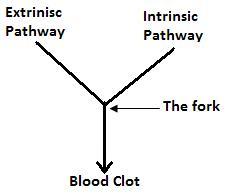
Figure 2: The blood-clotting cascade of land-dwelling vertebrates with both intrinsic and extrinsic pathways labeled (click on graphic to see the full diagram):5
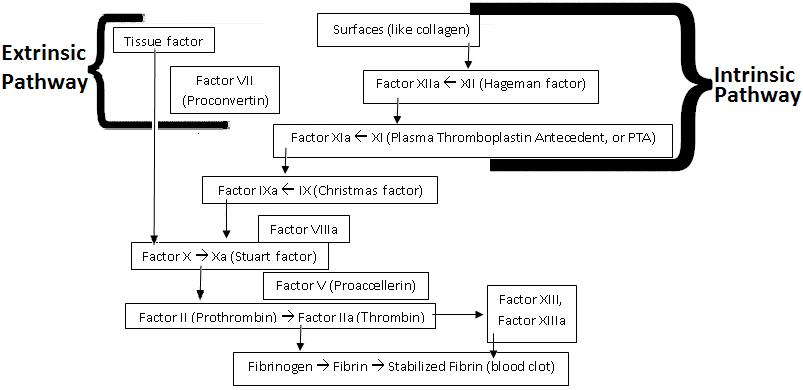
In Darwin’s Black Box, Behe specifically stated that his argument for irreducible complexity only pertained to irreducible complexity “beyond the fork” where the intrinsic and extrinsic blood-clotting cascades converge. As Behe writes:
“Leaving aside the system before the fork in the pathway, where some details are less well known, the blood-clotting system fits the definition of irreducible complexity. … The components of the system (beyond the fork in the pathway) are fibrinogen, prothrombin, Stuart factor, and proaccelerin. … in the absence of any one of the components, blood does not clot, and the system fails.”6
Behe even explained this very point to Judge Jones, making it clear that his own argument was not as expansive as that of Pandas:
“The relative importance of the two pathways in living organisms is still rather murky. Many experiments on blood clotting are hard to do. And I go on to explain why they must be murky. And then I continue on the next slide. Because of that uncertainty, I said, let’s, leaving aside the system before the fork in the pathway, where some details are less well-known, the blood clotting system fits the definition of irreducible complexity. And I noted that the components of the system beyond the fork in the pathway are fibrinogen, prothrombin, Stuart factor, and proaccelerin. So I was focusing on a particular part of the pathway, as I tried to make clear in Darwin’s Black Box. If we could go to the next slide. Those components that I was focusing on are down here at the lower parts of the pathway. And I also circled here, for illustration, the extrinsic pathway. It turns out that the pathway can be activated by either one of two directions. And so I concentrated on the parts that were close to the common point after the fork. So if you could, I think, advance one slide. If you concentrate on those components, a number of those components are ones which have been experimentally knocked out such as fibrinogen, prothrombin, and tissue factor. And if we go to the next slide, I have red arrows pointing to those components. And you see that they all fall in the area of the blood clotting cascade that I was specifically restricting my arguments to. And if you knock out those components, in fact, the blood clotting cascade is broken. So my discussion of irreducible complexity was, I tried to be precise, and my argument, my argument is experimentally supported.”7
The components that Behe claimed were irreducibly complex are contained in the red box seen in the diagram of the land-dwelling vertebrate blood-clotting cascade below:
Figure 3: Components that Michael Behe argued comprised the irreducibly complex core of the blood-clotting cascade:8
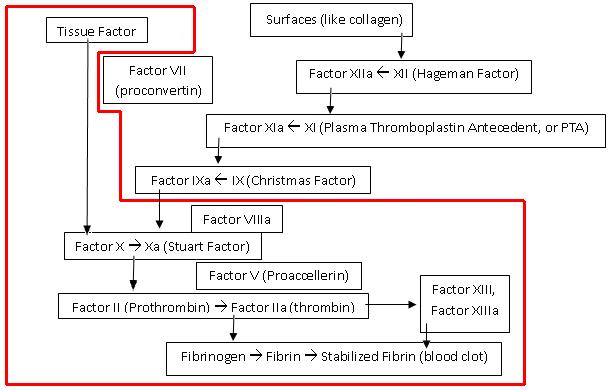
Behe provided Judge Jones with an experimentally verified case for irreducible complexity of the blood-clotting cascade with respect to particular proteins within the cascade: fibrinogen, prothrombin, and tissue factor. He discussed the cascade “after the fork” where the intrinsic and extrinsic pathways converge. Behe didn’t want to extend his argument too far, because adequate experimental tests had not yet been performed to demonstrate irreducible complexity with respect to some of the other factors, particularly those involved in the intrinsic pathway.
And Then Another Mirror
In his effort to refute Behe, Miller also discussed the fact that blood-clotting cascades in whales and dolphins lack factor XII (also called the Hageman factor), and the blood-clotting cascade in puffer fish lacks factors XI, XII, and XIIa. As Miller testified: “Whales and dolphins, in 1969, well before Pandas was published, were shown to lack factor 12. … The proposal is that we take away the three parts which are known as the contact phase system. Now, that includes factor 12, which we talked about a second ago, but also factor 11 and also the factor that catalyzes the conversion of 12 to the active form. It turns out these three parts are missing in a vertebrate known as the puffer fish.”9
Miller concluded that since these cascades “are missing three parts of the system and their blood clots perfectly well,” that therefore the irreducible complexity of the entire land-dwelling vertebrate blood-clotting cascade is “refuted by the scientific evidence.”10 The implication was that Behe’s argument for irreducible complexity of the blood-clotting cascade had been refuted as well as the more expansive argument in Pandas. But Miller did not refute Behe’s argument, because Miller only gave evidence that some vertebrates (like dolphins or jawed fish) lack certain components involved in the intrinsic pathway (factors XI, XII, and XIIA) found in land-dwelling vertebrates.
What Miller failed to acknowledge is that land-dwelling vertebrates, jawed-fish, and water-dwelling mammals like dolphins and whales still have the extrinsic pathway intact, as well as everything after the point where the intrinsic and extrinsic pathways combine in land-dwelling vertebrates. In other words, dolphins and jawed fish still have the factors in the blood-clotting cascade that Behe considers irreducibly complex (i.e. those “after the fork”). They even have the factors on the blood-clotting cascade’s extrinsic pathway. The only factors they appear to be missing are the portions on the intrinsic pathway. Since Behe’s argument did not include any of those factors on the intrinsic pathway, and only dealt with factors shared by jawed fish (like the puffer fish), water-dwelling mammals, and land-dwelling vertebrates, Miller’s argument did not refute Behe’s argument at all.
The Blood-Clotting Cascade’s Irreducible Core
The blood-clotting cascade pathway of jawed fish has an important difference from that of land-dwelling vertebrates because fish don’t have an intrinsic pathway found in land-dwelling vertebrates. That doesn’t mean that the rest of the cascade isn’t irreducibly complex, for both may have a core system of parts that is irreducibly complex. And how do we know there’s an irreducible core comprised of parts Miller didn’t address in his testimony? Because experimental evidence, cited by Michael Behe during the Kitzmiller trial and in Darwin’s Black Box, shows that some components of this system are absolutely necessary to have a functional blood-clotting system.
The “irreducible core” is a long-standing concept within ID thinking that William Dembski and Jonathan Wells define as follows:
“A functional system is irreducibly complex if it contains a multipart subsystem (i.e. a set of two or more interrelated parts) that cannot be simplified without destroying the system’s basic function. We call this multipart subsystem the system’s irreducible core. … We therefore define the core of a functionally integrated system as those parts that are indispensible to the system’s basic function: remove parts of the core, and you can’t recover the system’s basic function from the other remaining parts.”11
Dembski also discussed the concept of the “irreducible core” in his 2001 book No Free Lunch where he wrote, “Consider an old-fashioned pocket-watch with a winding mechanism. The basic function of the watch is to tell time. What’s more, many parts of the watch are indispensible to that basic function, for instances, the spring, the face, the hand, and the minute hand. On the other hand, other parts of the watch are dispensable, for instance the crystal, the metal cover holding the crystal, and the chain. By focusing purely on the indispensible parts of the pocket watch one obtains what can be called an irreducible core that has all the crucial properties of irreducibly complex systems considered so far. It therefore makes sense to define an irreducibly complex system as one that contains an irreducible core whose parts are each indispensible, but where the system is itself permitted to certain unnecessary or redundant elements.”12
I like to explain the “irreducible core” using the analogy of a bicycle: A bicycle has an irreducible core that requires a frame, two wheels, a motor mechanism (like legs on pedals), and a steering mechanism (like handle-bars attached to the front wheel). A bicycle also has a seat, but obviously you can ride a bike without a seat (though it wouldn’t be very fun). So, while the seat sure helps a lot, it is not part of the irreducible core of a bike. Same could be said for light deflectors, etc. So the fact that a bike has a couple dispensable parts doesn’t mean that there isn’t an irreducible core to a bike.
In this regard, under Miller’s style of argument, at the very least, the blood-clotting cascade of jawed fish and land-dwelling vertebrates might all share the parts seen in the diagram below, meaning that their blood-clotting cascade might have an irreducible core which looks like this (the diagram below basically shows the blood-clotting cascade of jawed-fish):
Figure 4: The blood-clotting cascade of jawed fish, which also represents the components of the blood-clotting cascade of land-dwelling vertebrates that Michael Behe argued formed an irreducibly complex core:13
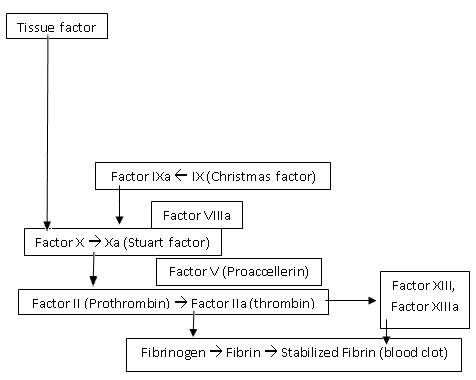
By finding that both jawed vertebrates and land-dwelling vertebrates contain all of the above components — the extrinsic pathway and everything “after the fork” — Miller’s arguments, at most, show that there is an irreducible core comprised of the components in the above diagram. Perhaps the intrinsic pathway of land-dwelling vertebrates (missing from this diagram) is not part of this irreducible core. If that’s the case, this does not refute irreducible complexity for the rest of the system; it just shows that those components in the intrinsic pathway aren’t indispensable to the system. The fact that land-dwelling vertebrates have an intrinsic pathway does NOT negate the existence of an irreducible core. Incidentally, this diagram contains all of the components which Behe said are part of the irreducible core. So Miller in no way refuted Behe.
Figure 5:14 This diagram shows the blood-clotting cascade of land-dwelling vertebrates. The red box shows the components that Michael Behe argues form the irreducibly complex core of the blood-clotting cascade. The green box shows the components which Ken Miller claims are dispensable to the blood-clotting cascade. Since the boxes don’t overlap, it can be seen that Miller didn’t even address Behe’s arguments. In other words, none of Miller’s comparative biochemistry examples of blood-clotting cascades in various species lacked any of the factors that Behe claimed were part of the irreducibly complex core. Nonetheless, Judge Jones had the temerity to rule that “scientists in peer-reviewed publications have refuted Professor Behe’s predication about the alleged irreducible complexity of the blood-clotting cascade.”15
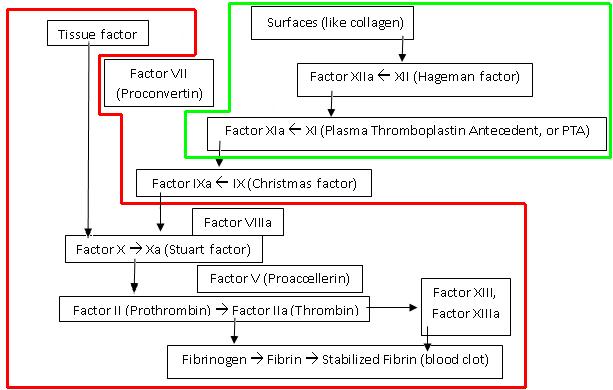
Pandas May Still Be Correct
As noted above, Pandas contended that the blood-clotting cascade of land-dwelling vertebrates requires all of its parts—including the intrinsic pathway, the extrinsic pathway, and all of the components that the pathways share in common after they converge (i.e. from factor X onward). The blood-clotting cascade of land-dwelling vertebrates, with the intrinsic and extrinsic pathways labeled, is again seen in Figure 6 below:
Figure 6: The figure below shows the full blood-clotting cascade of land-dwelling vertebrates. Jawed fish lack the intrinsic pathway found in humans and all other land-dwelling vertebrates. Miller’s logical mistake was assuming that this fact therefore implies that the intrinsic pathway is therefore dispensable to the blood-clotting cascade of land-dwelling vertebrates. Perhaps it is dispensible, but Miller’s evidence did not show that. Click on graphic to see the full diagram:16
Miller argued that because dolphins and jawed fish lack some components of the intrinsic pathway, that this shows that the entire land-dwelling vertebrate blood-clotting cascade is not irreducibly complex. But this is not a valid argument: Miller’s logical mistake was to forget that the fact that two systems are different, or the fact that System A does not have certain parts found in System B, does NOT necessarily mean that System A could evolve into B along a stepwise evolutionary path, or that system B is not irreducibly complex.
For example, consider again the bicycle. Bicycles have two wheels. Unicycles, having only one wheel, are missing an obvious component found on bicycles. Does this imply that you can remove one wheel from a bicycle and it will still function? Of course not. Try removing a wheel from a bike and you’ll quickly see that it requires two wheels to function. The fact that a unicycle lacks certain components of a bicycle does not mean that the bicycle is therefore not irreducibly complex.
Miller assumed that since jawed-fish / dolphins lack certain components found in the intrinsic blood clotting pathway of land-dwelling vertebrates, that therefore the land-dwelling vertebrate blood-clotting cascade is NOT irreducibly complex. But Miller didn’t cite an experiment that demonstrated that the blood-clotting cascade of land-dwelling vertebrates doesn’t require the intrinsic pathway. In other words, he never tried removing a wheel from the bike, which is the proper experiment to show that a bike is reducibly complex. Instead, Miller effectively said unicycles only have one wheel, so bikes don’t need both wheels. It’s an experimentally deficient and logically flawed argument.
Arguments about the irreducibly complex core aside, the entire land-dwelling vertebrate system might still be irreducibly complex, for the fact that some vertebrates lack factor XII (called Hageman Factor) in their blood-clotting cascade, or even lack the entire intrinsic pathway, in no way implies that humans (and other land-dwelling vertebrates) don’t require all of these components for their blood to clot. Miller didn’t cite the proper experimental data to show that the land-dwelling vertebrate blood-clotting cascade is reducibly complex. He just cited a unicycle, which as we’ve seen, isn’t sufficient to demonstrate the point he’s trying to make. Miller could only make this argument if he presented actual knockout experiments on the blood-clotting cascade of land-dwelling vertebrates that removed certain components from the blood-clotting cascade, and found that the blood still clotted properly. But Miller didn’t do anything like that.
In fact, no one has demonstrated an evolutionary pathway from the blood-clotting cascade of jawed fish to the blood-clotting cascade of land-dwelling vertebrates. In contrast, as Behe observes in Darwin’s Black Box, the blood-clotting cascade is irreducibly complex with respect to the extrinsic pathway and everything after the intrinsic and extrinsic pathways converge, i.e. from factor X onward (see the red box in Figure 5, above). As usual, Darwinists have used bogus comparisons to other living organisms to find other systems which COULD represent islands along an evolutionary pathway, but they need MUCH more evidence to demonstrate that the pathway exists.
Revealing Differences Between the Blood-Clotting Cascade of Land-Dwelling Vertebrates and Dolphins / Jawed Fish?
During the Kitzmiller trial, Ken Miller discussed the fact that dolphins (like jawed fish) lack factor XII (Hageman factor) in their blood-clotting cascade. This is interesting: Dolphins are supposedly descended from land-dwelling vertebrates (which have factor XII) but their condition is like jawed fish, which lack factor XII. This implies that there may be functional constraints on water-dwelling vertebrates to have a different activation pathway than land-dwelling vertebrates.
Darwinists like Ken Miller view the dolphin’s lack of factor XII as a case of convergent evolution, but we might also see it as evidence of a functional constraint or a case of common design. The fact that jawed fish lack factor XII is not necessarily evidence that their blood-clotting cascade was a “primitive evolutionary precursor” to the land-dwelling vertebrate blood-clotting cascade, but evidence of a functional constraint for water-dwelling vertebrates—a constraint which is confirmed in that dolphins also lack factor XII.
This is an interesting observation that may require further research to sort out. In the mean time, any claims that Miller refuted Behe—or even Pandas—appear to be premature.
Judges Should Not Be the Arbiters of Complex Scientific Questions about Origins
In light of those problems with Miller’s testimony, consider the patent falsity of Judge Jones’ claim that “scientists in peer-reviewed publications have refuted Professor Behe’s predication about the alleged irreducible complexity of the blood-clotting cascade”:
“[W]ith regard to the blood-clotting cascade, Dr. Miller demonstrated that the alleged irreducible complexity of the bloodclotting cascade has been disproven by peer-reviewed studies dating back to 1969, which show that dolphins’ and whales’ blood clots despite missing a part of the cascade, a study that was confirmed by molecular testing in 1998. (1:122-29 (Miller); P-854.17-854.22). Additionally and more recently, scientists published studies showing that in puffer fish, blood clots despite the cascade missing not only one, but three parts. (1:128-29 (Miller)). Accordingly, scientists in peer-reviewed publications have refuted Professor Behe’s predication about the alleged irreducible complexity of the blood-clotting cascade.”17
As the foregoing discussion made clear, Judge Jones’ assertion was simply wrong. This gives us further reason for understanding why federal judges should not become the arbiters of complex scientific questions about biological origins. Yet perhaps Judge Jones does not deserve the final blame for this mistake. After all, he simply copied this section dealing with blood clotting from the Plaintiffs’ “Findings of Fact and Conclusions of Law,” as seen in the table below:
| Judge Jones’ Kitzmiller ruling | Kitzmiller Plaintiffs’ Proposed “Findings of Fact and Conclusions of Law” |
| “Dr. Miller demonstrated that the alleged irreducible complexity of the blood-clotting cascade has been disproven by peer-reviewed studies dating back to 1969, which show that dolphins’ and whales’ blood clots despite missing a part of the cascade, a study that was confirmed by molecular testing in 1998. (1:122-29 (Miller); P-854.17-854.22). Additionally and more recently, scientists published studies showing that in puffer fish, blood clots despite the cascade missing not only one, but three parts. (1:128-29 (Miller)). Accordingly, scientists in peer-reviewed publications have refuted Professor Behe’s predication about the alleged irreducible complexity of the blood-clotting cascade.”18 | “Dr. Miller demonstrated that the alleged irreducible complexity of the blood-clotting cascade has been disproven by peer-reviewed studies going back to 1969, which showed that dolphins’ and whales’ blood clots despite missing a part of the cascade, a study that was confirmed by molecular testing in 1998. 1: 122-29; P854.17-854.22. More recently, scientists published studies showing that in puffer fish, blood clots despite the cascade missing not only one, but three parts. 1: 128-29. In sum, scientists in peer-reviewed publications have refuted Behe’s prediction about the alleged irreducible complexity of the blood-clotting cascade.”19 |
While Judge Jones’ copying was not improper as far as judicial ethics are concerned, the trivial non-substantive stylistic differences (italicized in the table above) between his ruling’s inaccurate treatment of blood clotting and the plaintiffs’ brief would make even a cheating high school student blush: “going back” becomes “dating back”; “More recently” becomes “Additionally and more recently”; “In sum” becomes “Accordingly.” And we’re left wondering, did Judge Jones intentionally take a subtle jab at Behe by changing “Behe’s prediction” to “Behe’s predication” (“predication” can mean “an act … of preaching“20)?
Of course, this isn’t the end of the story because Judge Jones copied over 90% of his section on whether ID is science in a verbatim or near-verbatim fashion from this ACLU brief.21 How much else did he get wrong? According to published analyses,22 an awful lot.
References Cited:
[1.] The author welcomes feedback and may be contacted at cluskin@discovery.org. The author also thanks Michael Behe, John West, and an un-named biochemist in the intelligent design movement for their editing assistance and feedback on this article.
[2.] Michael Behe, Darwin’s Black Box: The Biochemical Challenge to Evolution, pg. 39 (Free Press, 1996) (emphasis added).
[3.] Kitzmiller v. Dover, 400 F. Supp. 2d 707, 740 (M.D. Pa 2005).
[4.] Kenneth Miller, Kitzmiller v. Dover, September 26 AM testimony, pg. 108, emphasis added.
[5.] Information sources for figure: Of Pandas and People; Darwin’s Black Box; Wikipedia; Barbara Forrest, Paul Gross, “Biochemistry by design,” Trends in Biochemical Sciences, Vol. 32(7):301-310 (2007).
[6.] Michael Behe, Darwin’s Black Box: The Biochemical Challenge to Evolution, pg. 86 (Free Press, 1996), emphasis added.
[7.] Michael Behe, Kitzmiller v. Dover, Oct. 18 testimony, pg. 25-28, emphasis added.
[8.] Information sources for figure: Of Pandas and People; Darwin’s Black Box; Wikipedia; Barbara Forrest, Paul Gross, “Biochemistry by design,” Trends in Biochemical Sciences, Vol. 32(7):301-310 (2007).
[9.] Ken Miller, Kitzmiller v. Dover, September 26 AM testimony, pgs. 126-128.
[10.] Id. at pg. 129.
[11.] Jonathan Wells and William Dembski, The Design of Life: Discovering Signs of Intelligence in Biological Systems, pgs. 146-147 (Foundation for Thought and Ethics, 2008.
[12.] William A. Dembski, No Free Lunch: Why Specified Complexity Cannot Be Purchased Without Intelligence, pg. 285 (Rowman and Littlefield, 2001).
[13.] Information sources for figure: Of Pandas and People; Darwin’s Black Box; Wikipedia; Barbara Forrest, Paul Gross, “Biochemistry by design,” Trends in Biochemical Sciences, Vol. 32(7):301-310 (2007).
[14.] Information sources for figure: Of Pandas and People; Darwin’s Black Box; Wikipedia; Barbara Forrest, Paul Gross, “Biochemistry by design,” Trends in Biochemical Sciences, Vol. 32(7):301-310 (2007).
[15.] Kitzmiller v. Dover, 400 F. Supp. 2d 707, 740 (M.D. Pa 2005).
[16.] Information sources for figure: Of Pandas and People; Darwin’s Black Box; Wikipedia; Barbara Forrest, Paul Gross, “Biochemistry by design,” Trends in Biochemical Sciences, Vol. 32(7):301-310 (2007).
[17.] Judge John E. Jones III, Kitzmiller v. Dover, 400 F.Supp.2d 707, 740 (M.D.Pa 2005).
[18.] Kitzmiller v. Dover, 400 F. Supp. 2d 707, 740 (M.D. Pa 2005).
[19.] Kitzmiller v. Dover, Plaintiffs proposed “Findings of Fact and Conclusions of Law,” paragraph 75.
[20.] See http://www.merriam-webster.com/dictionary/predication.
[21.] See John G. West & David K. DeWolf, A Comparison of Judge Jones’ Opinion in Kitzmiller v. Dover with Plaintiffs’ Proposed “Findings of Fact and Conclusions of Law,” at http://www.discovery.org/f/1186
[22.] See David K. DeWolf, John West, Casey Luskin & Jonathan Witt, Traipsing into Evolution: Intelligent Design and the Kitzmiller v. Dover Decision (Discovery Inst. Press 2006); David K. DeWolf, John West, and Casey Luskin, “Intelligent Design Will Survive Kitzmiller v. Dover,” 68 Montana Law Review 7 (Winter, 2007), at http://www.discovery.org/f/1372